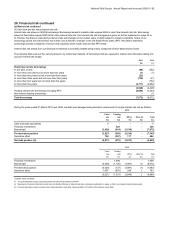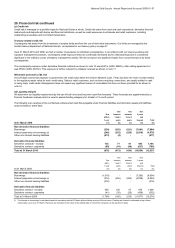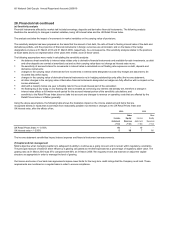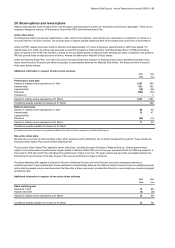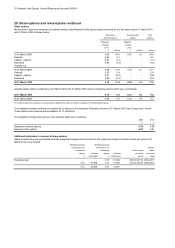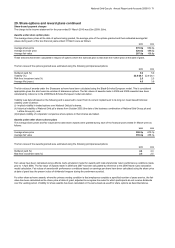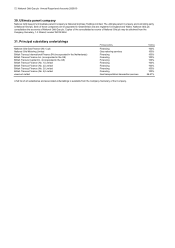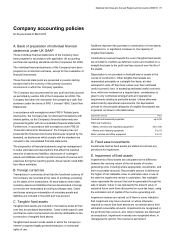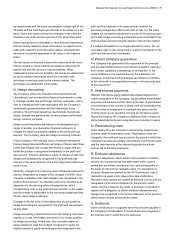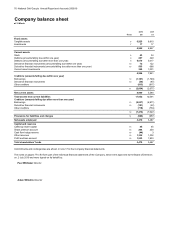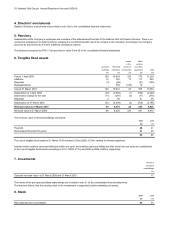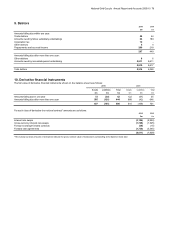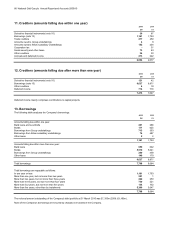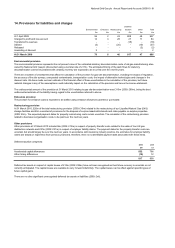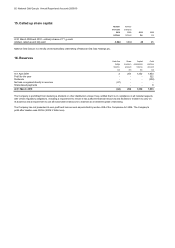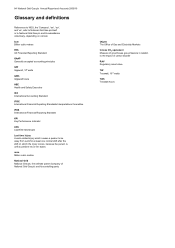National Grid 2010 Annual Report Download - page 77
Download and view the complete annual report
Please find page 77 of the 2010 National Grid annual report below. You can navigate through the pages in the report by either clicking on the pages listed below, or by using the keyword search tool below to find specific information within the annual report.National Grid Gas plc Annual Report and Accounts 2009/10 75
transactions are with the same counterparty, a legal right of set-
off exists and the cash flows are intended to be settled on a net
basis. Gains and losses arising from changes in fair value are
included in the profit and loss account in the period they arise.
Where derivatives are embedded in other financial instruments
that are closely related to those instruments, no adjustment is
made with respect to such derivative clauses. Otherwise the
derivative is recorded separately at fair value on the balance
sheet.
The fair values on financial instruments measured at fair value
that are quoted in active markets are based on bid prices for
assets held and offer prices for issued liabilities. When
independent prices are not available, fair values are determined
by using valuation techniques which are consistent with
techniques commonly used by the relevant market. The
techniques use observable market data.
N. Hedge accounting
The Company enters into derivative financial instruments
(‘derivatives’) and non-derivative financial instruments in order
to manage interest rate and foreign currency exposures, with a
view to managing these risks associated with the Company’s
underlying business activities and the financing of those
activities. The principal derivatives used include interest rate
swaps, forward rate agreements, currency swaps and forward
foreign currency contracts.
Hedge accounting allows derivatives to be designated as a
hedge of another (non-derivative) financial instrument, to
mitigate the impact of potential volatility in the profit and loss
account. The Company uses two hedge accounting methods.
Firstly, changes in the carrying value of financial instruments
that are designated and effective as hedges of future cash flows
(‘cash flow hedges’) are recognised directly in equity and any
ineffective portion is recognised immediately in the profit and
loss account. Amounts deferred in equity in respect of cash flow
hedges are subsequently recognised in the profit and loss
account in the same period in which the hedged item affects net
profit or loss.
Secondly, changes in the carrying value of financial instruments
that are designated as hedges of the changes in the fair value
of assets or liabilities (‘fair value hedges’) are recognised in the
profit and loss account. An offsetting amount is recorded as an
adjustment to the carrying value of hedged items, with a
corresponding entry in the profit and loss account, to the extent
that the change is attributable to the risk being hedged and that
the fair value hedge is effective.
Changes in the fair value of derivatives that do not qualify for
hedge accounting are recognised in the profit and loss account
as they arise.
Hedge accounting is discontinued when the hedging instrument
expires or is sold, terminated, exercised, or no longer qualifies
for hedge accounting. At that time, any cumulative gains or
losses relating to cash flow hedges recognised in equity are
initially retained in equity and subsequently recognised in the
profit and loss account in the same periods in which the
previously hedged item affects net profit or loss. For fair value
hedges the cumulative adjustment recorded to its carrying value
at the date hedge accounting is discontinued is amortised to the
profit and loss account using the effective interest rate method.
If a hedged transaction is no longer expected to occur, the net
cumulative gain or loss recognised in equity is transferred to the
profit and loss account immediately.
O. Parent Company guarantees
The Company has guaranteed the repayment of the principal
and any associated premium and interest on specific loans due
from certain subsidiary undertakings to third parties. In the
event of default or non-performance by the subsidiary, the
Company recognises such guarantees as insurance contracts,
at fair value with a corresponding increase in the carrying value
of the investment.
P. Share-based payments
National Grid issues equity-settled share-based payments to
certain employees of the Company. Equity-settled share-based
payments are measured at fair value at the date of grant based
on an estimate of the number of shares that will eventually vest.
This fair value is recognised on a straight-line basis over the
vesting period, as an operating cost and an increase in equity.
Payments made by the Company to National Grid in respect of
share-based payments are recognised as a reduction in equity.
Q. Restructuring costs
Costs arising from the Company’s restructuring programmes
primarily relate to redundancy costs. Redundancy costs are
charged to the profit and loss account in the period in which the
Company becomes irrevocably committed to incurring the costs
and the main features of the restructuring plan have been
announced to affected employees.
R. Emission allowances
Emission allowances, which relate to the emissions of carbon
dioxide, are recorded as an intangible asset within current
assets and are initially recorded at cost, and subsequently at
the lower of cost and net realisable value. For allocations of
emission allowances granted by the UK Government, cost is
deemed to be equal to fair value at the date of allocation.
Receipts of such grants are treated as deferred income and are
recognised in the income statement in the period in which
carbon dioxide emissions are made. A provision is recorded in
respect of the obligation to deliver emission allowances and
charges are recognised in the income statement in the period in
which carbon dioxide emissions are made.
S. Dividends
Interim dividends are recognised when they become payable to
the Company’s shareholders. Final dividends are recognised in
the financial year in which they are approved.


